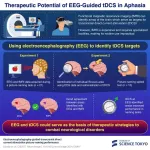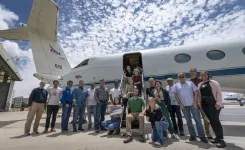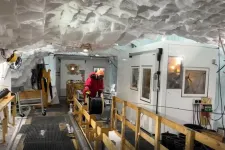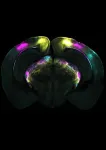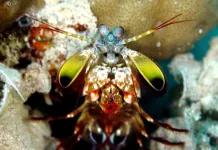(Press-News.org) COLUMBUS, Ohio – Scientists have developed a novel tool designed to protect and conserve coral reefs by providing them with an abundance of feeding opportunities.
The device, dubbed the Underwater Zooplankton Enhancement Light Array (UZELA), is an autonomous, programmable underwater light that works to draw in nearby zooplankton, microscopic organisms that coral feed on.
After testing the submersible on two species of coral native to Hawaii over six months, researchers found that UZELA could greatly enhance local zooplankton density and increase the feeding rates of both healthy and bleached coral. Importantly, providing coral with greater amounts of food makes them stronger and more likely to be resilient against certain environmental threats, like heat stress or ocean acidification.
This result is impressive, especially at a time when rising ocean temperatures are forcing entire coral reefs to the cusp of collapse, said Andrea Grottoli, lead author of the study and a professor of earth sciences at The Ohio State University.
“Coral reefs house one-third of all marine species, yet occupy less than 1% of the ocean,” she said. “They are disproportionately responsible for ocean health and we’re at risk of losing them.”
The study was recently published in the journal Limnology and Oceanography: Methods.
Millions of humans rely on coral reefs, as they support fishing industries and protect coastline communities from dangers like erosion and floods. Unfortunately, many climate models project that at Earth’s current rate of warming, these vital coral reefs may be completely devastated by 2050, jeopardizing the complex ecosystems they sustain.
Although the technology in this study is only a short-term solution to the environmental threats that coral reefs face, the device will likely be very beneficial to coral restoration efforts, said Grottoli. “Think of it as a band-aid for about a couple decades,” she said. “It can protect some corals in some places, sometimes.”
The team also found that UZELA, which can be powered for half a year on a single battery, could optimize a coral’s feeding time by operating for just one hour after dusk.
Understandably, artificial lights can disrupt the behavior of other marine animals, so researchers could choose not to use the device year-round. That said, the study emphasizes that corralling zooplankton with this human-made tool doesn’t seem to harm the environment or interrupt the flow of other zooplankton in the surrounding area.
“If you imagine zooplankton in a column floating above coral, instead of being naturally dispersed, UZELA is just pulling them down, but it’s not taking away from the coral beside it,” said Grottoli. “We show that if you put the coral close to the light, they benefit from that concentrated zooplankton, and feeding rates go up 10- to 50-fold.”
This number is equivalent to an 18-68% increase in the amount of metabolic demand that can be met by zooplankton alone, meaning that increased feeding helps supplement a large part of the coral’s diet, which successfully leads to an increase in coral survivorship and persistence.
“The real intent of this project is to inject new technology and energy into coral restoration success,” Grottoli said. “It’s something that can be deployed strategically for high-value reefs, or projects that have already had a lot of investment in them.”
Widely adaptable to various marine environments, UZELA can also easily be serviced by divers once placed in optimal underwater locations.
Notably, while the current generation of UZELAs are handmade, the team is working with an Ohio-based engineering company to redesign the technology to make it more manufacturable. Grottoli expects these more enhanced versions will be available within the next one to three years.
“We are not mitigating climate change fast enough to save coral, and UZELA is not going to instantly save coral reefs,” she said. “But it is an exciting solution that will buy us time as we work toward a more sustainable environment.”
Other co-authors include Shannon Dixon and Ann Marie Hulver from Ohio State as well as Claire Bardin, Claire Lewis, Christopher Suchocki and Rob Toonen from the University of Hawai’i at Manoa and the Hawaii Institute of Marine Biology.
The study was supported by the University of Hawai’i Foundation, the National Science Foundation and the Defense Advanced Research Projects Agency.
#
Contact: Andrea Grottoli, Grottoli.1@osu.edu
Written by: Tatyana Woodall, Woodall.52@osu.ed
END
Electroencephalography (EEG) may offer a more accessible alternative to functional magnetic resonance imaging (fMRI) for guiding transcranial direct current stimulation (tDCS) when treating aphasia. Researchers from Institute of Science Tokyo found an 80% agreement between EEG and fMRI in identifying brain regions activated during language tasks. Furthermore, EEG-guided tDCS improved picture-naming speed in participants, indicating its potential for innovative therapies in language disorders.
Many neurological disorders are directly linked to damage or deterioration in specific regions of the brain. For example, ...
Measurements and data collected from space can be used to better understand life on Earth.
An ambitious, multinational research project funded by NASA and co-led by UC Merced civil and environmental engineering Professor Erin Hestir demonstrated that Earth’s biodiversity can be monitored and measured from space, leading to a better understanding of terrestrial and aquatic ecosystems. Hestir led the team alongside University of Buffalo geography Professor Adam Wilson and Professor Jasper Slingsby from the University ...
Embargoed for release: Thursday, February 6, 2025, 2:00 PM ET
Key points:
Comprehensive genetic mapping of Plasmodium knowlesi, a zoonotic parasite that causes malaria, has revealed the genes required for malaria infection of the blood, and those driving drug resistance.
By identifying specific druggable targets and determinants of resistance, the map provides insights that could help the development of new therapeutics.
Boston, MA—A new, comprehensive map of all the genes essential for blood infections in Plasmodium knowlesi (P. ...
In brief:
• In Greenland, an international team of researchers led by ETH Zurich has discovered that countless tiny ice quakes take place deep inside ice streams.
• These quakes are responsible for the fact that ice streams also move with a continuous stick-slip motion and not only like viscous honey as previously considered.
• The researchers recorded seismic data from inside the ice stream using a fibre-optic cable in a 2,700-metre deep borehole.
The ...
Whale song can be as efficient as – and, in some cases, more efficient than – human communication, according to a new study in Science Advances. Meanwhile, new unrelated research in Science further investigates whale song’s adherence to a universal linguistic law, as observed in recordings of humpback whales.
Natural selection favors the pithy over the longwinded. For example, yelling “Duck!” is faster and far more effective than shouting “Be careful, there is an incoming projectile, and you need to move out of the way!” ...
Researchers have uncovered a neural mechanism in the brains of mice that enables them to override instinctive fear responses; dysfunction in this mechanism may contribute to inappropriate or excessive fear responses, they say. According to the findings, targeting these circuits could offer new therapeutic avenues for treating fear-related disorders like post-traumatic stress disorder and anxiety. Fear responses to visual threats, such as escaping from an approaching predator, are critical instinctive reactions for survival and are ...
The hormone adrenomedullin disrupts insulin signaling in blood vessel cells, contributing to systemic insulin resistance in obesity-associated type 2 diabetes, according to a new study. Blocking adrenomedullin’s effects restores insulin function and improves glucose control in a mouse model, suggesting a potential new target for treating obesity-related metabolic disease. Diabetes is a leading global cause of illness, mortality, and healthcare expenditures, with most cases stemming from obesity-induced insulin resistance and type 2 diabetes mellitus. Insulin resistance primarily ...
In this Special Issue of Science, 3 Reviews and a Policy Forum highlight research on Earth’s frozen places – from the Arctic to the Antarctic – and how it’s changing due to climate change and the geopolitical challenges this important work faces. In the first Review, Julienne Stroeve and colleagues provide a preview of what the Arctic region may look like in a warmer world. Without stronger climate action, global temperatures are set to rise +2.7°C above preindustrial levels, ...
Researchers at the Sainsbury Wellcome Centre (SWC) at UCL have unveiled the precise brain mechanisms that enable animals to overcome instinctive fears. Published today in Science, the study in mice could have implications for developing therapeutics for fear-related disorders such as phobias, anxiety and post-traumatic stress disorder (PTSD).
The research team, led by Dr Sara Mederos and Professor Sonja Hofer, mapped out how the brain learns to suppress responses to perceived threats that prove ...
Known for their powerful punch, mantis shrimp can smash a shell with the force of a .22 caliber bullet. Yet, amazingly, these tough critters remain intact despite the intense shockwaves created by their own strikes.
Northwestern University researchers have discovered how mantis shrimp remain impervious to their own punches. Their fists, or dactyl clubs, are covered in layered patterns, which selectively filter out sound. By blocking specific vibrations, the patterns act like a shield against self-generated shockwaves.
The study will be published on Friday (Feb. 7) in the journal Science.
The findings someday could be applied to developing ...
